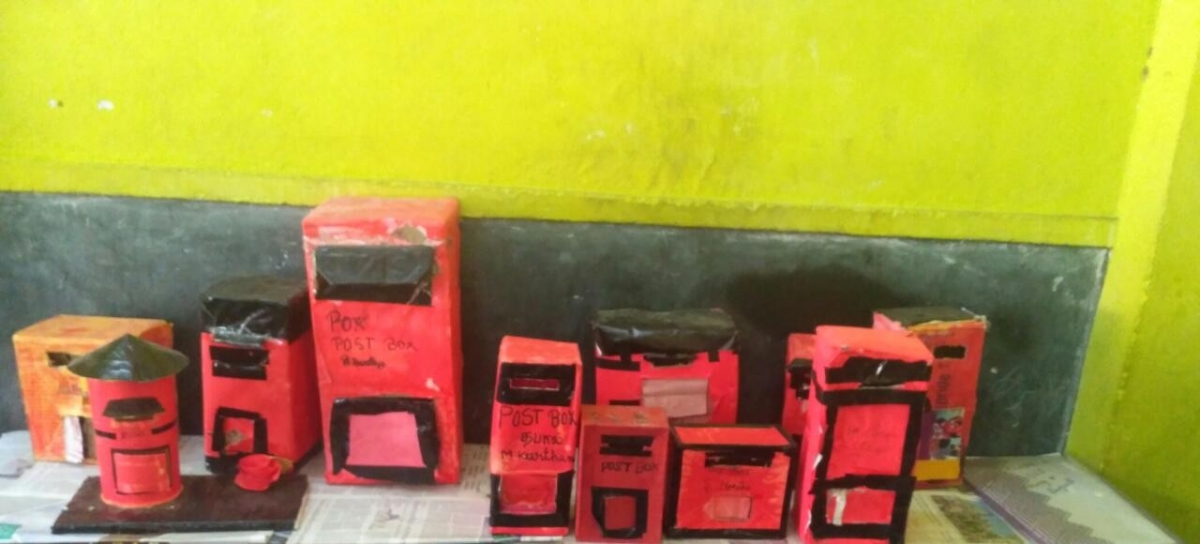Letter writing is a theme that appears in both EVS and English in the third term for the students of grade 3. The lessons covering this topic include ‘Here comes a letter’ in EVS and ‘What’s in the mail box?’ in English. These two lessons deal with the idea of letter-writing and the journey of a letter. Letters were the most important means of communication before the advent of telephone calls and e-mails and other social media. I had decided to cover this topic with the help of some activities so that both the lessons could be discussed. This would also allow me to managing time efficiently as well. Moreover, I wanted to conduct activities that are child-centric so that the learning could be made effective.
Activities planned:
The two main things that were planned are to celebrate a ‘Letter-writing Day’ and making a model post-box. While the first activity would allow for the discussion regarding the main aspects of letters and letter-writing, the second activity was planned to be a fun activity for students.
Letter-writing Day:
Letter-writing Day was celebrated as a special event in school to discuss about letter writing—its uses and its journey. Different types of letters—inland letters, post cards, postal covers—were shown to the students. A brief history of how communication evolved was also shared with the students—from birds being used as messengers to people manually traveling from one place to another with messages and even the current means through which we communicate. Different pictures were made available to the students to help them understand what was being discussed.
Following this, the origin of letters, postal service, and aligned service of postal departments were explained to the students. The telegram service, something that was stopped due to development in the field of communication, was also explained.
After the discussion, the students were shown a video regarding the journey of a letter (https://www.youtube.com/watch?v=GzkPXQrvApc). Since it was the time of the Pongal festival, the students were encouraged to send letters to their friends greeting them for the festivities. The students were taught how to write an address properly with the correct pin code. With the help of a model letter that was displayed on a chart for all to see, we discussed about letter-writing. All the students brought the addresses of their friends and relatives and greeted them in their letter. The students were taught about the uses of stamps. Stamps of different denominations that are used presently were also shown to the students—Rs. 5 stamps, Rs. 10 stamps, Re.1 revenue stamps. All the letters were dropped in the nearby post-box.
Making a letter box:
The students were made to collect carton boxes from their home and bring them to school. Red and black papers were used to wrap the box to make a letter box. Each student made letter boxes and displayed them in the classroom. The students wrote letters to their friends in the class and posted it in their respective letter boxes. They were quite excited to write letters and post them to their friends. However, the students were more excited upon receiving letters from their friends.

Observations and reflection:
- It was a wonderful experience teaching two subjects in a collaborative manner. The students were able to comprehend the matter quite easily and enjoy the class, since the activities were children-centric where they learnt things by doing it themselves.
- The students wrote letters to their friends and family members even after the programme had been concluded.
- Writing letters will help students to develop their language skills.
- Reading letters from friends were an interesting experience for the students.
- The teachers should guide the students at each stage of writing a letter. Support can be provided to the students by giving them words or templates that they could to use in the letter.
- The activities can be designed in manner so as to integrate different lessons from different subjects. Doing a collaborative syllabus-analysis of the textbook will help teachers in achieving that.
Term: Term 3
- Log in or register to post comments